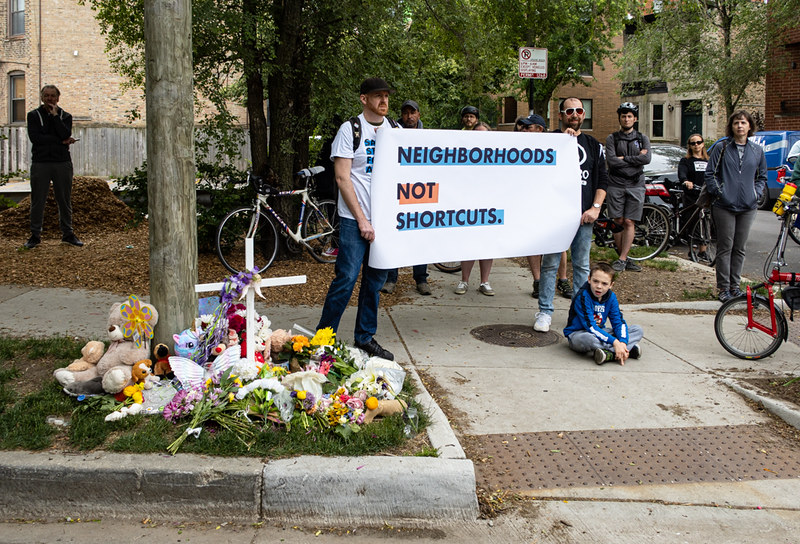Over the weekend, more than 300 people took to the streets to honor two young children recently killed by drivers on Chicago’s North Side.
The memorial event — held for Raphael “Rafi” Cardenas and Elizabeth “Lily” Grace Shambrook — was attended by people who were demanding that the city take action to make our streets safe places to walk and bike.
These recent tragedies, combined with the increasing number of people getting killed by drivers while walking and biking in Chicago, prompted the Active Transportation Alliance to issue an urgent message to city leaders.
We sent the following letter today to Chicago Mayor Lori Lightfoot and Chicago Department of Transportation Commissioner Gia Biagi.
_______________________________________________________
Dear Mayor Lightfoot and Commissioner Biagi,
I am writing today with an urgent call to action to make our streets safer.
On June 12, hundreds of residents gathered to mourn the passing of two young children, two-year-old Rafi Cardenas and three-year-old Lily Grace. Both children were killed in preventable crashes caused by unsafe street design. Rafi was using a crosswalk and Lily was riding on her mother’s bike on a designated bike route. These are the places we tell people they can safely walk and bike. Not long after the event memorializing these tragedies, another pedestrian was struck and killed nearby while crossing Irving Park Road. Another day in a city that has handed over too much space to cars and trucks, while failing to keep people walking and biking safe.
The City of Chicago must do more to slow car and truck speeds and volume, especially on neighborhood streets like the ones where Rafi and Lily were killed, and to make our public ways safe for pedestrians and cyclists.
- Neighborhood Greenways should feature hard infrastructure to slow down traffic to safe speeds and to deter many cars and trucks from using the street altogether. The segment of Leland where Lily Grace died includes only dashed painted bike lanes. Features like concrete curb extensions, bump outs, and raised crosswalks and intersections would transform Leland and other greenways into much safer streets.
- The prevalence of large trucks in serious and fatal bike and pedestrian crashes across Chicago continues to raise alarms. While Chicago has made strides to improve truck safety and install side-guards where it has direct control, city and state officials and private companies must do more to require sideguards and high-visibility mirrors on all large trucks, and better manage truck volume on local streets.
- We know the city can deliver high-quality bicycle infrastructure and address the danger of large trucks on our roadways. We are excited by recently announced plans to bring concrete curb protected bike lanes to W. Augusta Blvd. But these efforts continue to fall short relative to the scale of needed improvements — and the consequences have been deadly. Creating a connected, concrete protected network city wide must be a top and urgent priority of the city.
The reasons given by the City of Chicago for slow and patchwork progress include lack of funding, lack of staff capacity, the parking meter deal, an unsupportive state DOT, and aldermanic and community opposition. None of these are insurmountable, especially in this moment when Chicago has dedicated capital dollars for bike facilities. We need bold leadership and the will to take decisive action and confront ill-informed opposition to commonsense changes.
We are eager to work with you to address the following obstacles.
- What level of staff capacity will it take to break the log jam and scale up our bike project delivery? How can we program that into next year’s city budget?
- How can we update our citywide complete streets policy to ensure that the highest-quality infrastructure is installed anytime a roadway is touched for improvements? What if Chicago became the national model for safe roadway design standards?
- What will replace the Mayor’s Bicycle Advisory Council and Mayor’s Pedestrian Advisory Council? How do we create an accessible forum for residents from across the city to inform and shape the city’s transportation planning and projects?
- Will the city join with advocates in advancing state legislation or other policies to challenge the intransigence of IDOT in addressing the dangerous roadways in Chicago under its jurisdiction? How do we get this on the city’s legislative agenda for the next session?
- Why do we continue to allow aldermen to have veto power over projects on the public way? How can we formalize a more inclusive and participatory decision-making process for the public way?
- What will it take for the city to dedicate its lobbying power to push for changes of state policies related to truck safety? What would a coordinated effort at changing truck safety policy in Illinois look like?
We are eager to act and to partner with you as we mobilize, educate, hold officials accountable, and fight for needed policy change — so that all Chicagoans have the safe streets we deserve.
Sincerely,
Amy Rynell
Executive Director
Active Transportation Alliance
__________________________________________________

